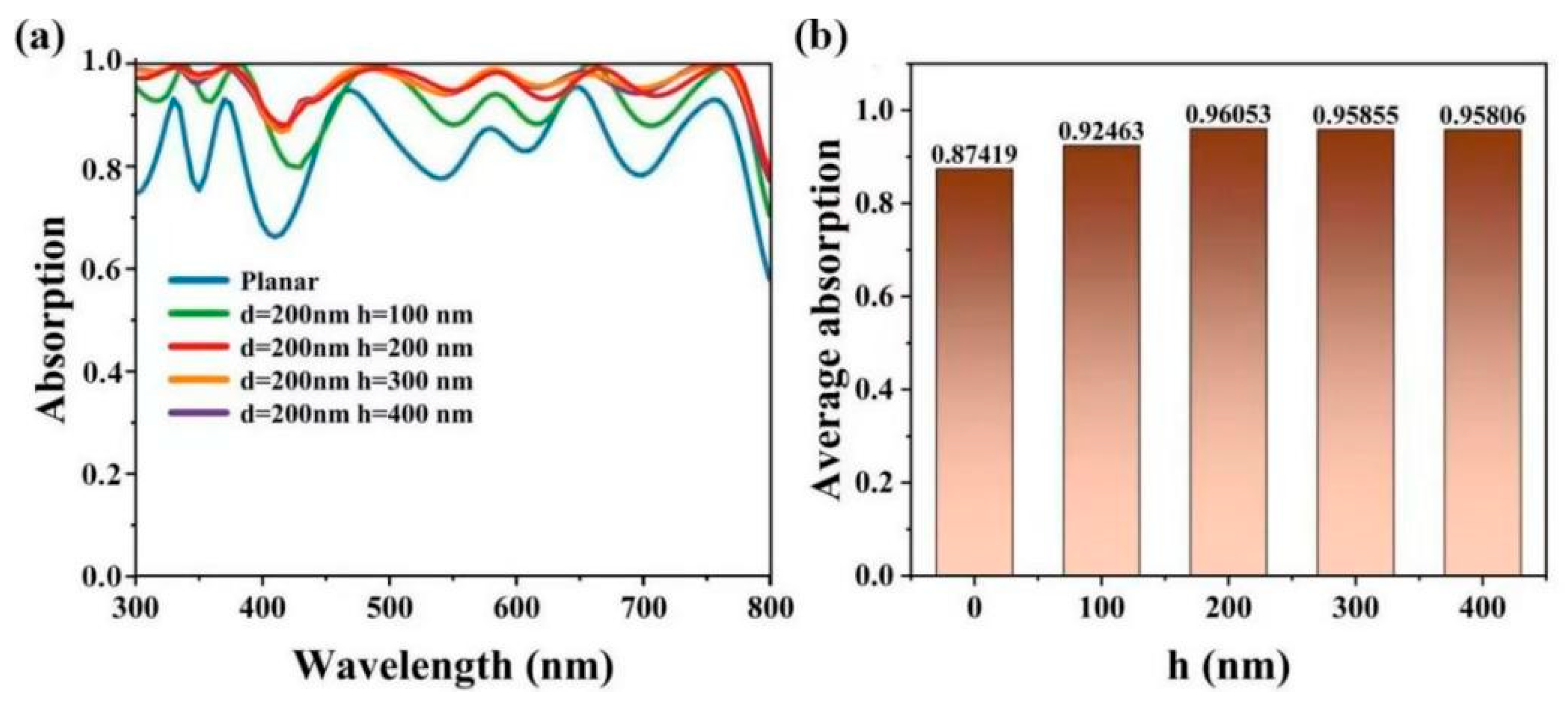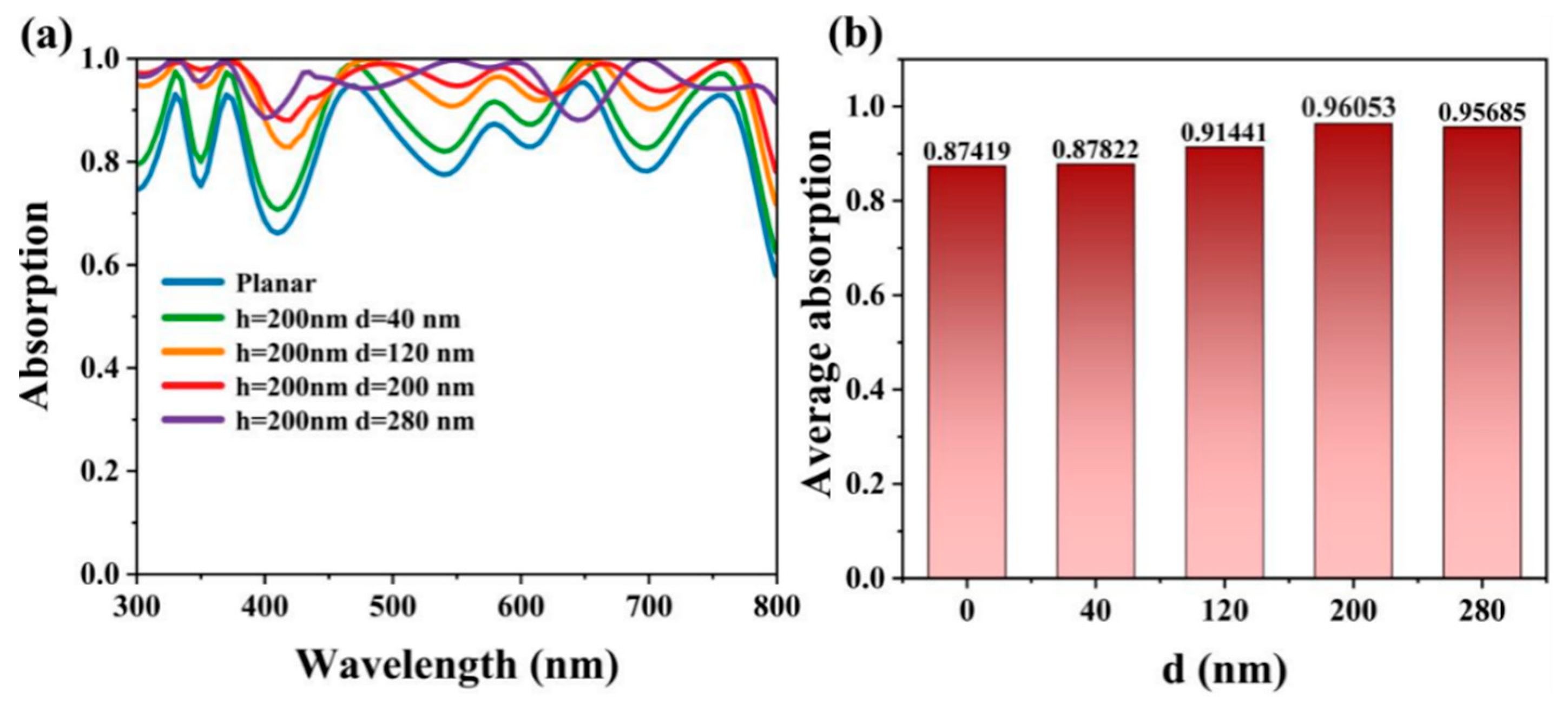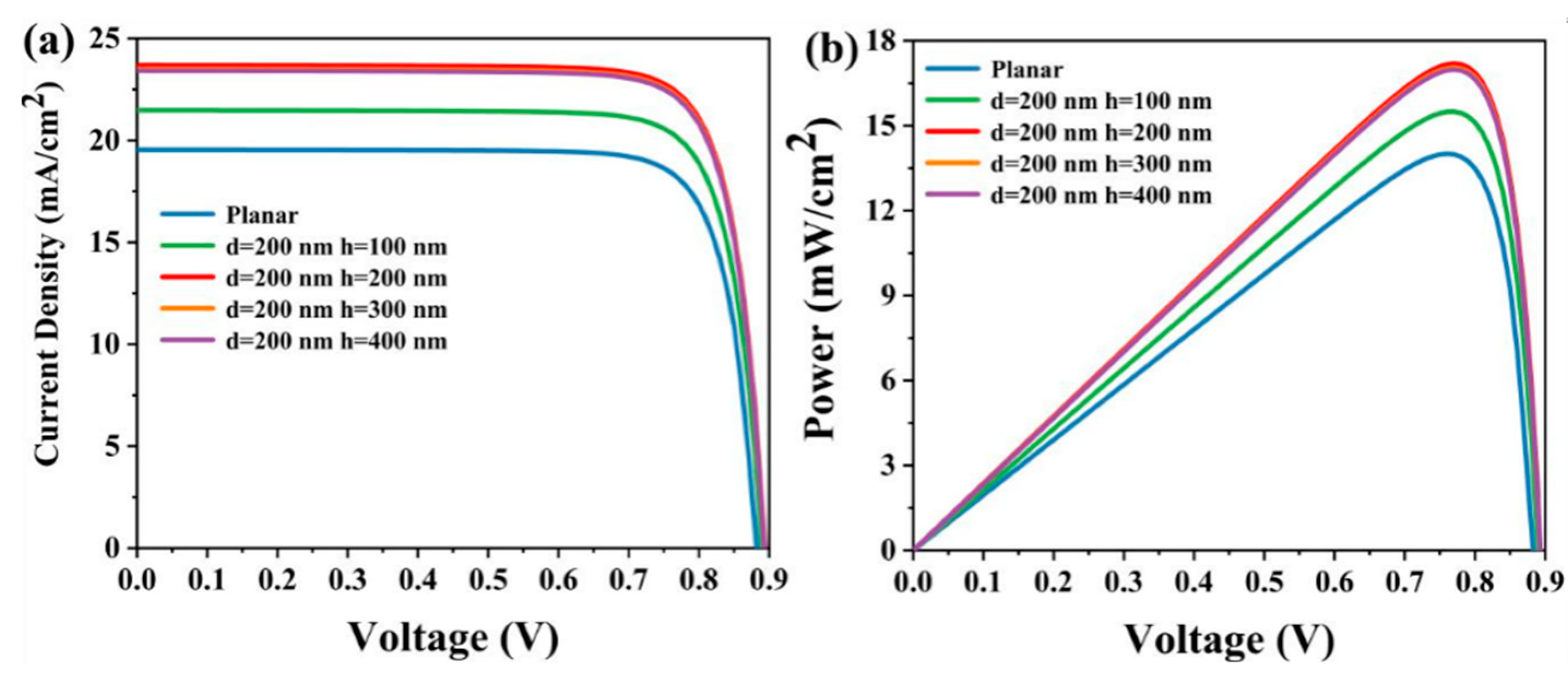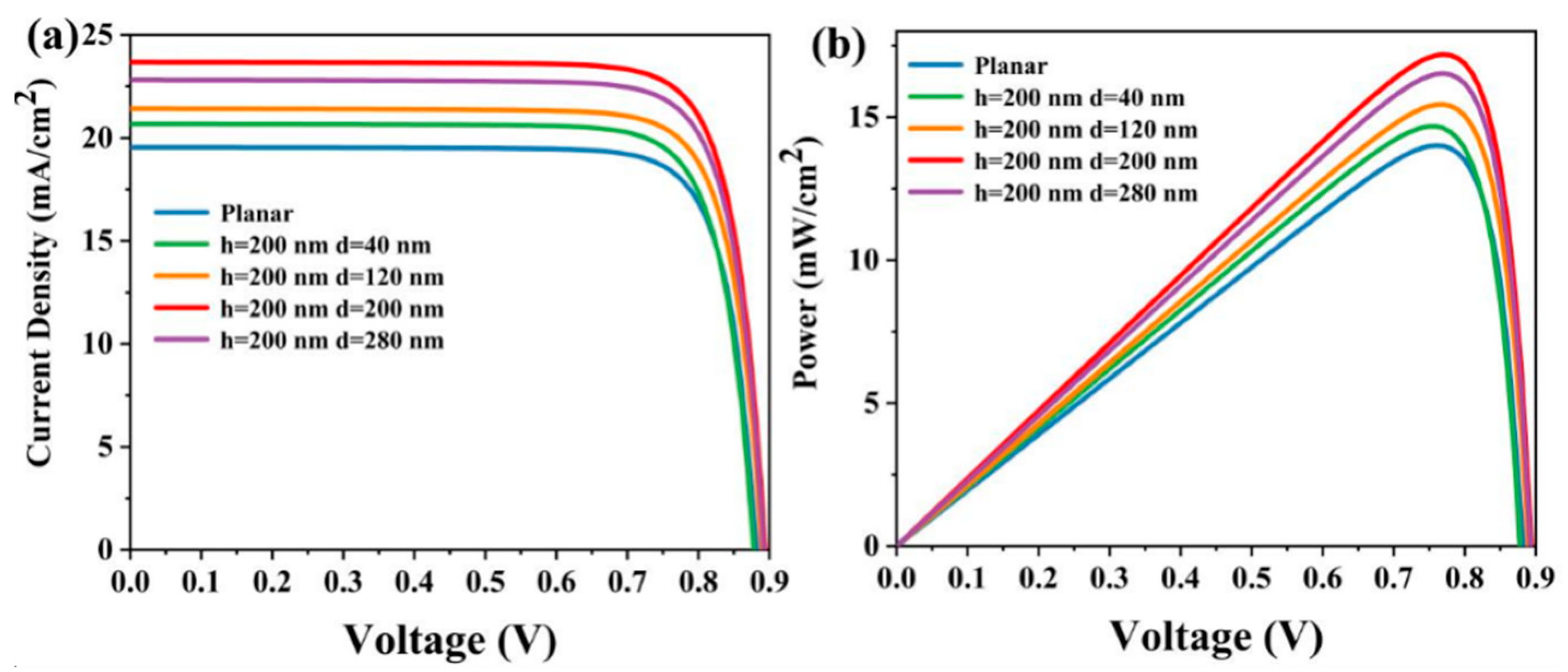Enhancing the Overall Performance of Perovskite Solar Cells with a Nano-Pyramid Anti-Reflective Layer
Abstract
1. Introduction
2. Model Structure
3. Results and Analysis
4. Conclusions
Author Contributions
Funding
Institutional Review Board Statement
Informed Consent Statement
Data Availability Statement
Conflicts of Interest
References
- Park, N.G. Perovskite solar cells: An emerging photovoltaic technology. Mater. Today 2015, 18, 65–72. [Google Scholar] [CrossRef]
- Serpetzoglou, E.; Konidakis, I.; Kourmoulakis, G.; Demeridou, I.; Chatzimanolis, K.; Zervos, C.; Kioseoglou, G.; Kymakis, E.; Stratakis, E. Charge carrier dynamics in different crystal phases of CH3NH3PbI3 perovskite. Opto-Electron. Sci. 2022, 1, 210005. [Google Scholar] [CrossRef]
- Heo, J.H.; You, M.S.; Chang, M.H.; Yin, W.; Ahn, T.K.; Lee, S.J.; Sung, S.J.; Kim, D.H.; Im, S.H. Hysteresis-less mesoscopic CH3NH3PbI3 perovskite hybrid solar cells by introduction of Li-treated TiO2 electrode. Nano Energy 2015, 15, 530–539. [Google Scholar] [CrossRef]
- Shen, T.Y.; Qin, J.J.; Bai, Y.J.; Zhang, J.; Shi, L.; Hou, X.; Zi, J.; Hu, B. Giant magneto field effect in up-conversion amplified spontaneous emission via spatially extended states in organic-inorganic hybrid perovskites. Opto-Electron. Adv. 2022, 5, 200051. [Google Scholar] [CrossRef]
- Han, Q.C.; Liu, S.W.; Liu, Y.Y.; Jin, J.S.; Li, D.; Cheng, S.B.; Xiong, Y. Flexible counter electrodes with a composite carbon/metal nanowire/polymer structure for use in dye-sensitized solar cells. Sol. Energy 2020, 208, 469–479. [Google Scholar] [CrossRef]
- Lu, T.W.; Lin, Y.; Zhang, T.Q.; Huang, Y.; Fan, X.; Lai, S.; Lu, Y.; Kuo, H.-C.; Chen, Z.; Wu, T.; et al. Self-polarized RGB device realized by semipolar micro-LEDs and perovskite-in-polymer films for backlight applications. Opto-Electron. Adv. 2024, 7, 230210. [Google Scholar] [CrossRef]
- Maleki, J.; Eskandari, M.; Fathi, D. PbS-TBAI/MoSe2-grating as new hole transport layer in perovskite solar cells: Superior efficiency enhancement thru simulation and optimization. J. Alloys Compd. 2023, 960, 170653. [Google Scholar] [CrossRef]
- Zhang, Y.; Yi, Y.; Li, W.; Liang, S.; Ma, J.; Cheng, S.; Yang, W.; Yi, Y. High Absorptivity and Ultra-Wideband So-lar Absorber Based on Ti-Al2O3 Cross Elliptical Disk Arrays. Coatings 2023, 13, 531. [Google Scholar] [CrossRef]
- Mortadi, A.; El Hafidi, E.; Monkade, M.; El Moznine, R. Investigating the influence of absorber layer thickness on the performance of perovskite solar cells: A combined simulation and impedance spectroscopy study. Mater. Sci. Energy Technol. 2024, 7, 158–165. [Google Scholar] [CrossRef]
- Zheng, Y.; Wang, Z.Y.; Yi, Z.; Cheng, S.B.; Ma, C.; Tang, B.; Sun, T.Y.; Yu, S.J.; Li, G.F.; Ahmad, S. A wide-band solar absorber based on tungsten nano-strip resonator group and graphene for near-ultraviolet to near-infrared re-gion. Diam. Relat. Mater. 2024, 142, 110843. [Google Scholar] [CrossRef]
- Elbanna, A.; Chaykun, K.; Lekina, Y.; Liu, Y.D.; Febriansyah, B.; Li, S.; Pan, J.; Shen, Z.X.; Teng, J. Perovskite-transition metal dichalcogenides heterostructures: Recent advances and future perspectives. Opto-Electron. Sci. 2022, 1, 220006. [Google Scholar] [CrossRef]
- Waddell, E.; Gibson, D.; Lin, L.; Fu, X. Modelling and optimization of film thickness variation for plasma enhanced chemical vapour deposition processes. Proc. SPIE-Int. Soc. Opt. Eng. 2013, 8168, 259–264. [Google Scholar] [CrossRef]
- Thomas, S.; Nalini, S.; Kumar, K.R. Microwave plasma-assisted ALD of Al2O3 thin films: A study on the substrate temperature dependence of various parameters of interest. Appl. Phys. A 2017, 123, 185. [Google Scholar] [CrossRef]
- Aliyariyan, M.; Fathi, D.; Eskandari, M.; Tooghi, A. Efficiency enhancement of perovskite solar cells by designing GeSe nanowires in the structure of adsorbent layer. Nanotechnology 2020, 31, 465405. [Google Scholar] [CrossRef] [PubMed]
- Mohammadi, M.H.; Fathi, D.; Eskandari, M. NiO@GeSe core-shell nano-rod array as a new hole transfer layer in perovskite solar cells: A numerical study. Sol. Energy 2020, 204, 200–207. [Google Scholar] [CrossRef]
- Mohammadi, M.H.; Fathi, D.; Eskandari, M. Light trapping in perovskite solar cells with plasmonic core/shell nanorod array: A numerical study. Energy Rep. 2021, 7, 1404–1415. [Google Scholar] [CrossRef]
- Aliyariyan, M.; Fathi, D.; Eskandari, M.; Mohammadi, M.H. Simulation and investigation of perovskite/nano-pyramidal GeSe solar cell: Realizing high efficiency by controllable light trapping. Sol. Energy 2021, 214, 310–318. [Google Scholar] [CrossRef]
- Chen, J.Y.; Yu, M.H.; Chang, S.F.; Sun, K.W. Highly efficient poly (3,4-ethylenedioxythiophene): Poly (styrenesulfonate)/Si hybrid solar cells with imprinted nanopyramid structures. Appl. Phys. Lett. 2013, 103, 133901. [Google Scholar] [CrossRef]
- Xiao, T.X.; Tu, S.; Liang, S.Z.; Guo, R.J.; Tian, T.; Müller-Buschbaum, P. Solar cell-based hybrid energy harvesters towards sustainability. Opto-Electron. Sci. 2023, 2, 230011. [Google Scholar] [CrossRef]
- Leem, J.W.; Kim, S.; Lee, S.H.; Rogers, J.A.; Kim, E.; Yu, J.S. Efficiency Enhancement of Organic Solar Cells Using Hydrophobic Antireflective Inverted Moth-Eye Nanopatterned PDMS Films. Adv. Energy Mater. 2014, 4, 1301315. [Google Scholar] [CrossRef]
- Park, C.H.; Kim, J.Y.; Sung, S.-J.; Kim, D.-H.; Do, Y.S. Design of Grating Al2O3 Passivation Structure Optimized for High-Efficiency Cu(In,Ga)Se2 Solar Cells. Sensors 2021, 21, 4849. [Google Scholar] [CrossRef] [PubMed]
- Liang, S.R.; Xu, F.; Li, W.X.; Yang, W.X.; Cheng, S.B.; Yang, H.; Chen, J.; Yi, Z.; Jiang, P.P. Tunable smart mid infrared thermal control emitter based on phase change material VO2 thin film. Appl. Therm. Eng. 2023, 232, 121074. [Google Scholar] [CrossRef]
- Fan, W.; Shen, H.; Liu, B.; Zhao, L.; Zhang, X.; Pan, H. Influence of Al2O3/SiNx Rear-Side Stacked Passivation on the Performance of Polycrystalline PERC Solar Cells. Energies 2023, 16, 6963. [Google Scholar] [CrossRef]
- Gu, Y.; Chen, S.; Lin, J.; Xu, H.; Li, X. High-quality efficient anti-reflection nanopillar structures layer prepared by a new type vibration-assisted UV nanoimprint lithography. J. Manuf. Process. 2021, 61, 461–472. [Google Scholar] [CrossRef]
- Park, J.; Kim, J.; Yun, H.S.; Paik, M.J.; Noh, E.; Mun, H.J.; Kim, M.G.; Shin, T.J.; Seok, S.I. Controlled growth of perovskite layers with volatile alkylammonium chlorides. Nature 2023, 616, 724–730. [Google Scholar] [CrossRef] [PubMed]
- Liang, S.; Cheng, S.; Zhang, H.; Yang, W.; Yi, Z.; Zeng, Q.; Tang, B.; Wu, P.; Ahmad, S.; Sun, T. Structural color tunable intelligent mid-infrared thermal control emitter. Ceram. Int. 2024, 50, 23611–23620. [Google Scholar] [CrossRef]
- Cheng, S.; Li, W.; Zhang, H.; Akhtar, M.N.; Yi, Z.; Zeng, Q.; Ma, C.; Sun, T.; Wu, P.; Ahmad, S. High sensitivity five band tunable metamaterial absorption device based on block like Dirac semimetals. Opt. Commun. 2024, 569, 130816. [Google Scholar] [CrossRef]
- Ma, J.; Wu, P.H.; Li, W.X.; Liang, S.R.; Shangguan, Q.Y.; Cheng, S.B.; Tian, Y.H.; Fu, J.Q.; Zhang, L.B. A five-peaks graphene ab-sorber with multiple adjustable and high sensitivity in the far infrared band. Diam. Relat. Mater. 2023, 136, 109960. [Google Scholar] [CrossRef]
- Maksimovic, J.; Hu, J.W.; Ng, S.H.; Katkus, T.; Seniutinas, G.; Rivera, T.P.; Stuiber, M.; Nishijima, Y.; John, S.; Juodkazis, S.; et al. Beyond Lambertian light trapping for large-area silicon solar cells: Fabrication methods. Opto-Electron. Adv. 2022, 5, 210086. [Google Scholar] [CrossRef]
- Xiong, H.; Deng, J.H.; Yang, Q.; Wang, X.; Zhang, H. A metamaterial energy power detector based on electro-magnetic energy harvesting technology. ACS Appl. Electron. Mater. 2024, 6, 1204–1210. [Google Scholar] [CrossRef]
- Li, W.X.; Zhao, W.C.; Cheng, S.B.; Zhang, H.F.; Yi, Z.; Sun, T.Y.; Wu, P.H.; Zeng, Q.D.; Raza, R. Tunable Metamaterial Absorption Device based on Fabry–Perot Resonance as Temperature and Refractive Index Sensing. Opt. Lasers Eng. 2024, 181, 108368. [Google Scholar] [CrossRef]
- Gigli, C.; Leo, G. All-dielectric χ(2) metasurfaces: Recent progress. Opto-Electron. Adv. 2022, 5, 210093. [Google Scholar] [CrossRef]
- Chen, Z.Y.; Cheng, S.B.; Zhang, H.F.; Yi, Z.; Tang, B.; Chen, J.; Zhang, J.G.; Tang, C.J. Ultra wideband absorption absorber based on Dirac semimetallic and graphene metamaterials. Phys. Lett. A 2024, 517, 129675. [Google Scholar] [CrossRef]
- Xiong, H.; Ma, X.D.; Wang, B.X.; Zhang, H.Q. Design and analysis of an electromagnetic energy conversion device. Sens. Actuators A Phys. 2024, 366, 114972. [Google Scholar] [CrossRef]
- Luo, J.; Zhang, J.H.; Gao, S.S. Design of Multi-Band Bandstop Filters Based on Mixed Electric and Magnetic Coupling Resonators. Electronics 2024, 13, 1552. [Google Scholar] [CrossRef]
- Li, W.; Cheng, S.; Zhang, H.; Yi, Z.; Tang, B.; Ma, C.; Wu, P.; Zeng, Q.; Raza, R. Multi-functional metasurface: Ul-tra-wideband/multi-band absorption switching by adjusting guided mode resonance and local surface plasmon resonance effects. Commun. Theor. Phys. 2024, 76, 065701. [Google Scholar] [CrossRef]
- Li, W.X.; Liu, Y.H.; Ling, L.; Sheng, Z.X.; Cheng, S.B.; Yi, Z.; Wu, P.H.; Zeng, Q.D.; Tang, B.; Ahmad, S. The tunable absorber films of grating structure of AlCuFe quasicrystal with high Q and refractive index sensitivity. Surf. Inter-Faces 2024, 48, 104248. [Google Scholar] [CrossRef]
- Deng, X.; Shui, T.; Yang, W.X. Inelastic two-wave mixing induced high-efficiency transfer of optical vortices. Opt. Express 2024, 32, 16611–16628. [Google Scholar] [CrossRef] [PubMed]
- Liang, X.; Guan, H.; Luo, K.; He, Z.; Liang, A.; Zhang, W.; Lin, Q.; Yang, Z.; Zhang, H.; Xu, C.; et al. Van der Waals integrated LiNbO3/WS2 for High-Performance UV-Vis-NIR Photodetection. Laser Photonics Rev. 2023, 17, 2300286. [Google Scholar] [CrossRef]
- Li, W.X.; Liu, M.S.; Cheng, S.B.; Zhang, H.F.; Yang, W.X.; Yi, Z.; Zeng, Q.D.; Tang, B.; Ahmad, S.; Sun, T.Y. Po-lar-ization inde-pendent tunable bandwidth absorber based on single-layer graphene. Diam. Relat. Mater. 2024, 142, 110793. [Google Scholar] [CrossRef]
- Xie, Y.; Liu, Z.; Zhou, F.; Luo, X.; Gong, Y.; Cheng, Z.; You, Y. Tunable nonreciprocal metasurfaces based on nonlinear quasi-Bound state in the Continuum. Opt. Lett. 2024, 49, 3520–3523. [Google Scholar] [CrossRef] [PubMed]
- Zhu, J.; Xiong, J.Y. Logic operation and all-optical switch characteristics of graphene surface plasmons. Opt. Express 2023, 31, 36677. [Google Scholar] [CrossRef] [PubMed]
- Li, W.X.; Xu, F.; Cheng, S.B.; Yang, W.X.; Liu, B.; Liu, M.S.; Yi, Z.; Tang, B.; Chen, J.; Sun, T.Y. Six-band rotation-ally symmetric tunable absorption film based on AlCuFe quasicrystals. Opt. Laser Technol. 2024, 169, 110186. [Google Scholar] [CrossRef]
- Kumar, P.; Huang, S.-H.; Hsu, C.-Y.; Chung, S.-Y.; Cha, H.-C.; Chuang, C.-M.; Chen, K.-L.; Huang, Y.-C. Enhancing Power Conversion Efficiency of Organic Solar Cells with Magnetoplasmonic Fe3O4@Au@m-ABS Nanoparticles. Nanomaterials 2024, 14, 1175. [Google Scholar] [CrossRef]
- Luo, J. Dynamical behavior analysis and soliton solutions of the generalized Whitham–Broer–Kaup–Boussineq–Kupershmidt equations. Results Phys. 2024, 60, 107667. [Google Scholar] [CrossRef]
- He, Z.; Guan, H.; Liang, X.; Chen, J.; Xie, M.; Luo, K.; An, R.; Ma, L.; Ma, F.; Yang, T.; et al. Broadband, polarization-sensitive, and self-powered high-performance photodetection of hetero-integrated MoS2 on lithium niobate. Research 2023, 6, 0199. [Google Scholar] [CrossRef] [PubMed]
- David, C.; Koduvelikulathu, L.J.; Kopecek, R. Comparative Simulations of Conductive Nitrides as Alternative Plasmonic Nanostructures for Solar Cells. Energies 2021, 14, 4236. [Google Scholar] [CrossRef]
- Shangguan, Q.; Zhao, Y.; Song, Z.; Wang, J.; Yang, H.; Chen, J.; Liu, C.; Cheng, S.; Yang, W.; Yi, Z. High sensitivi-ty active adjustable graphene absorber for refractive index sensing applications. Diam. Relat. Mater. 2022, 128, 109273. [Google Scholar] [CrossRef]
- Li, W.; Ma, J.; Zhang, H.; Cheng, S.; Yang, W.; Yi, Z.; Yang, H.; Zhang, J.; Wu, X.; Wu, P. Tunable broadband ab-sorber based on a layered resonant structure with a Dirac semimetal. Phys. Chem. Chem. Phys. 2023, 25, 8489–8496. [Google Scholar] [CrossRef] [PubMed]
- Lei, W.; He, Q.; Yang, L.; Jiao, H. Solar Photovoltaic Cell Parameter Identification Based on Improved Honey Badger Algorithm. Sustainability 2022, 14, 8897. [Google Scholar] [CrossRef]
- Deng, J.H.; Xiong, H.; Yang, Q.; Wang, B.X.; Zhang, H.Q. Metasurface-based Microwave Power Detector for Polarization Angle Detection. IEEE Sens. J. 2023, 23, 22459–22465. [Google Scholar] [CrossRef]
- Li, W.X.; Zhao, W.C.; Cheng, S.B.; Yang, W.X.; Yi, Z.; Li, G.F.; Zeng, L.C.; Li, H.L.; Wu, P.H.; Cai, S.S. Terahertz Selec-tive Active Electromagnetic Absorption Film Based on Single-layer Graphene. Surf. Interfaces 2023, 40, 103042. [Google Scholar] [CrossRef]
- Zhang, T.X.; Tao, C.; Ge, S.X.; Pan, D.W.; Li, B.; Huang, W.X.; Wang, W.; Chu, L.Y. Interfaces coupling defor-mation mechanisms of liquid-liquid-liquid three-phase flow in a confined microchannel. Chem. Eng.-Ing. J. 2022, 434, 134769. [Google Scholar] [CrossRef]
- Alamri, Y.A.; Mahmoud, S.; Al-Dadah, R.; Sharma, S.; Roy, J.N.; Ding, Y. Optical Performance of Single Point-Focus Fresnel Lens Concentrator System for Multiple Multi-Junction Solar Cells—A Numerical Study. Energies 2021, 14, 4301. [Google Scholar] [CrossRef]
- Liang, S.; Xu, F.; Yang, H.; Cheng, S.; Yang, W.; Yi, Z.; Song, Q.; Wu, P.; Chen, J.; Tang, C. Ultra long infrared met-amaterial absorber with high absorption and broad band based on nano cross surrounding. Opt. Laser Technol. 2023, 158, 108789. [Google Scholar] [CrossRef]
- Li, W.; Yi, Y.; Yang, H.; Cheng, S.; Yang, W.X.; Zhang, H.; Yi, Z.; Yi, Y.; Li, H. Active Tunable Terahertz Band-width Absorber Based on single layer Graphene. Commun. Theor. Phys. 2023, 75, 045503. [Google Scholar] [CrossRef]
- Ma, Z.; Li, R.; Xiong, R.; Zhang, Y.; Xu, C.; Wen, C.; Sa, B. InSe/Te van der Waals Heterostructure as a High-Efficiency Solar Cell from Computational Screening. Materials 2021, 14, 3768. [Google Scholar] [CrossRef] [PubMed]
- Shangguan, Q.; Chen, H.; Yang, H.; Liang, S.; Zhang, Y.; Cheng, S.; Yang, W.; Yi, Z.; Luo, Y.; Wu, P. A “bel-fry-typed” narrow-band tunable perfect absorber based on graphene and the application potential research. Diam. Relat. Mater. 2022, 125, 108973. [Google Scholar] [CrossRef]
- Shui, T.; Chen, X.M.; Yang, W.X. Coherent control of spatial and angular Goos-Hänchen shifts with spontaneously generated co-herence and incoherent pumping. Appl. Opt. 2022, 61, 10072–10079. [Google Scholar] [CrossRef] [PubMed]
- Shangguan, Q.; Chen, Z.; Yang, H.; Cheng, S.; Yang, W.; Yi, Z.; Wu, X.; Wang, S.; Yi, Y.; Wu, P. Design of Ul-tra-Narrow Band Graphene Refractive Index Sensor. Sensors 2022, 22, 6483. [Google Scholar] [CrossRef] [PubMed]
- Wu, F.Y.; Liu, Y.H.; Ling, L.; Sheng, Z.X.; Yi, Z.; Song, Q.J.; Cheng, S.B.; Tang, B.; Ahmad, S.; Sun, T.Y. Spectrally Selective Ultra-Broadband Solar Absorber Based on Pyramidal Structure. Adv. Photonics Res. 2024, 5, 2300305. [Google Scholar] [CrossRef]
- Zhu, J.; Xiong, J.Y. Tunable terahertz graphene metamaterial optical switches and sensors based on plasma-induced transparency. Measurement 2023, 220, 113302. [Google Scholar] [CrossRef]
- Fu, R.; Chen, K.X.; Li, Z.L.; Yu, S.H.; Zheng, G.X. Metasurface-based nanoprinting: Principle, design and advances. Opto-Electron. Sci. 2022, 1, 220011. [Google Scholar] [CrossRef]
- Zheng, Y.; Zhao, W.; Song, Q.; Ma, C.; Yi, Z.; Zeng, Q.; Sun, T.; Chen, J.; Yan, J. Analysis of solar absorption and thermal radiation properties of a multi-layer structure. Int. J. Therm. Sci. 2024, 203, 109172. [Google Scholar] [CrossRef]
- Gao, H.; Fan, X.; Wang, Y.; Liu, Y.; Wang, X.; Xu, K.; Deng, L.; Zeng, C.; Li, T.; Xia, J.; et al. Multi-foci metalens for spectra and polarization ellipti-city recognition and reconstruction. Opto-Electron. Sci. 2023, 2, 220026. [Google Scholar] [CrossRef]
- Xiong, H.; Ma, X.D.; Liu, H.S.; Xiao, D.P.; Zhang, H.Q. Research on Electromagnetic Energy Absorption and Conversion Device with Four-Ring Multi-Resistance Structure. Appl. Phys. Lett. 2023, 123, 153902. [Google Scholar] [CrossRef]
- Sang, T.; Mi, Q.; Yang, C.Y.; Zhang, X.H.; Wang, Y.K.; Ren, Y.Z.; Xu, T. Achieving asymmetry parameter-insensitive resonant modes through relative shift–induced quasi-bound states in the continuum. Nanophotonics 2024, 13, 1369–1377. [Google Scholar] [CrossRef]
- Baeva, M.; Gets, D.; Polushkin, A.; Vorobyov, A.; Goltaev, A.; Neplokh, V.; Mozharov, A.; Krasnikov, D.V.; Nasibulin, A.G.; Mukhin, I.; et al. ITO-free silicon-integrated perovskite electrochemical cell for light-emission and light-detection. Opto-Electron. Adv. 2023, 6, 220154. [Google Scholar] [CrossRef]
- Lee, S.M.; Kwong, A.; Jung, D.; Faucher, J.; Biswas, R.; Shen, L.; Kang, D.; Lee, M.L.; Yoon, J. High Performance Ultrathin GaAs Solar Cells Enabled with Heterogeneously Integrated Dielectric Periodic Nanostructures. ACS Nano 2015, 9, 10356–10365. [Google Scholar] [CrossRef] [PubMed]








| H (nm) | VOC (V) | JSC (mA/cm2) | PCE (%) |
|---|---|---|---|
| Planar | 0.89 | 19.18 | 14.01 |
| 100 | 0.89 | 21.48 | 15.50 |
| 200 | 0.90 | 23.54 | 17.19 |
| 300 | 0.90 | 23.41 | 17.06 |
| 400 | 0.90 | 23.32 | 16.98 |
| d (nm) | VOC (V) | JSC (mA/cm2) | PCE (%) |
|---|---|---|---|
| Planar | 0.89 | 19.18 | 14.01 |
| 40 | 0.89 | 20.68 | 14.67 |
| 120 | 0.89 | 21.42 | 15.44 |
| 200 | 0.90 | 23.54 | 17.19 |
| 280 | 0.90 | 22.81 | 16.52 |
Disclaimer/Publisher’s Note: The statements, opinions and data contained in all publications are solely those of the individual author(s) and contributor(s) and not of MDPI and/or the editor(s). MDPI and/or the editor(s) disclaim responsibility for any injury to people or property resulting from any ideas, methods, instructions or products referred to in the content. |
© 2024 by the authors. Licensee MDPI, Basel, Switzerland. This article is an open access article distributed under the terms and conditions of the Creative Commons Attribution (CC BY) license (https://creativecommons.org/licenses/by/4.0/).
Share and Cite
Liu, L.; Liu, W.; Fu, W.; Yi, Z.; Yi, Y.; Zhang, J.; Tang, C.; Sun, T.; Zeng, Q.; Wu, P. Enhancing the Overall Performance of Perovskite Solar Cells with a Nano-Pyramid Anti-Reflective Layer. Photonics 2024, 11, 715. https://doi.org/10.3390/photonics11080715
Liu L, Liu W, Fu W, Yi Z, Yi Y, Zhang J, Tang C, Sun T, Zeng Q, Wu P. Enhancing the Overall Performance of Perovskite Solar Cells with a Nano-Pyramid Anti-Reflective Layer. Photonics. 2024; 11(8):715. https://doi.org/10.3390/photonics11080715
Chicago/Turabian StyleLiu, Li, Wenfeng Liu, Wenfeng Fu, Zao Yi, Yougen Yi, Jianguo Zhang, Chaojun Tang, Tangyou Sun, Qingdong Zeng, and Pinghui Wu. 2024. "Enhancing the Overall Performance of Perovskite Solar Cells with a Nano-Pyramid Anti-Reflective Layer" Photonics 11, no. 8: 715. https://doi.org/10.3390/photonics11080715
APA StyleLiu, L., Liu, W., Fu, W., Yi, Z., Yi, Y., Zhang, J., Tang, C., Sun, T., Zeng, Q., & Wu, P. (2024). Enhancing the Overall Performance of Perovskite Solar Cells with a Nano-Pyramid Anti-Reflective Layer. Photonics, 11(8), 715. https://doi.org/10.3390/photonics11080715







